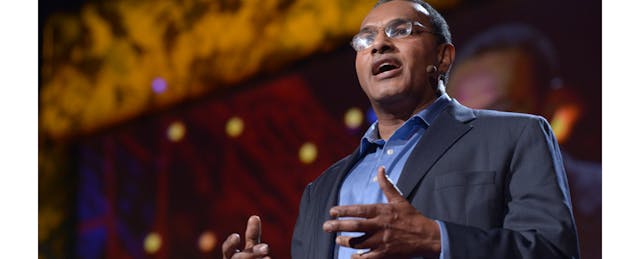Freeman Hrabowski III, is a college president who has long fought for civil rights and racial justice. When he was 12 years old, he marched with Martin Luther King Jr. in Birmingham, Alabama—and got arrested. Such protests in the 1960s were crucial, he says, but largely symbolic.
For most of Hrabowski’s long career he says he has been trying to “move the needle” in a more concrete way—to increase the number of African Americans in STEM fields, and to bring in other underrepresented groups as well.
Hrabowski has been president of the University of Maryland, Baltimore County for nearly 30 years, and one of his signature programs there is called the Meyerhoff Scholars Program. Its goal is to help more minority students major in STEM fields, finish college, and become leaders in science and tech once they graduate.
The program is a proven success. A 2019 article in the journal Science found “no other major university has achieved similar outcomes” when it comes to retaining diverse students in STEM fields. And the program’s alumni are becoming leaders in their fields. A former Meyerhoff Scholar, Kizzmekia Corbett, helped create one of the COVID-19 vaccines and was named to TIME magazine’s Next 100 list of innovators.
But even this highly successful program has limits to how much it can do all by itself. And the challenge of bringing diversity to STEM is huge. Only about 2 percent of U.S. Ph.D.s in science and tech disciplines are going to African Americans each year.
So these days, Hrabowski is working harder than ever to share the secret sauce of the program. And big-name colleges are adopting it, including the University of North Carolina at Chapel Hill and Pennsylvania State University.
For this week’s EdSurge Podcast, we connected with Hrabowski to talk about his long quest—and why today is such a critical moment in the fight to diversify science and tech.
EdSurge: Take us back to when you first started at UMBC and talk about why you viewed that as a key problem you wanted to solve.
Freeman Hrabowski: I've always seen the problem as very personal in the sense that, throughout school, I found that most people did not like math and science. As I got older, I realized math was at the base of much of what we do in science and engineering. And when I went to grad school at Illinois, I typically was the only Black in the class, and never saw a Black professor in STEM, ever.
If people don't see professionals in disciplines looking like themselves—whether it's public health or medicine or engineering—they will tend to think, ‘This is not for me.’ We saw that during this COVID crisis—if they didn't have examples of people of color who were physicians or our scientists, people of color and others who did not trust the science did not trust the scientists because often they didn't see people looking like themselves.
What are the basic components of the program you developed at UMBC to try to diversify STEM fields?
The four pillars are, one, high expectations—not just of the students, but other faculty, of the staff. Number two, building community so that it's not cutthroat, so that people work to help each other. Number three, and really important, it takes researchers to produce researchers or scientists to produce scientists. And finally, rigorous evaluation.
How would you put today's period of activism around antiracism into some context. How do you see this moment as different than the 1960s?
I see these periods as very similar in terms of where our country is in thinking about these issues. We are very divided now and we were very divided then. People forget that, unfortunately, President Kennedy couldn't get things through Congress just because we were so divided. It took a southerner, Lyndon Johnson, to get the Civil Rights Act passed, and then the Higher Education Act and the Voting Rights Act.
The real question is always after the march—which was symbolically important to shed light on the issue, but then the real work begins. And the real work involves everything from legislation to policy changes. And that's where we are right now, as we think about how to pull people together to find a common ground. And what I would say is one part of that common ground can be found through educating more people.
Hear the complete interview on the EdSurge Podcast feed, where Hrabowski talks about how to encourage other colleges to add diversity programs in STEM fields. We also talk to an alum of the program about how it inspired and worked for her.


